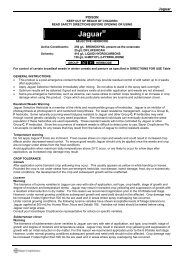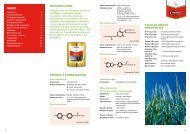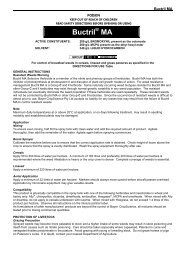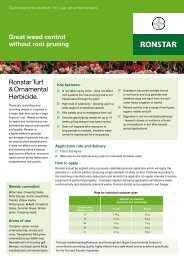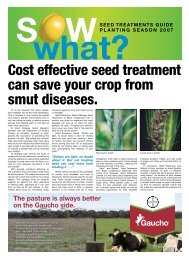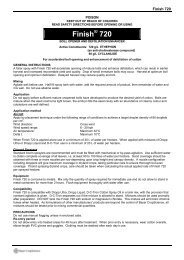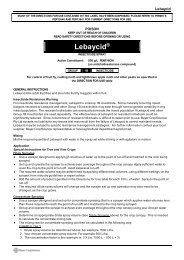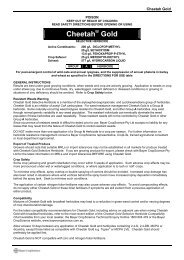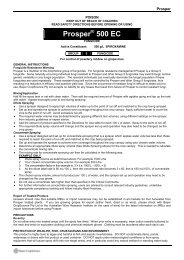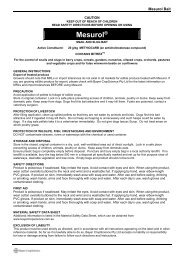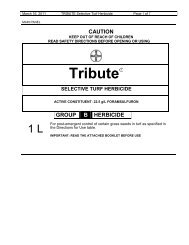Basta web label - Bayer CropScience
Basta web label - Bayer CropScience
Basta web label - Bayer CropScience
You also want an ePaper? Increase the reach of your titles
YUMPU automatically turns print PDFs into web optimized ePapers that Google loves.
<strong>Basta</strong><br />
CAUTION<br />
KEEP OUT OF REACH OF CHILDREN<br />
READ SAFETY DIRECTIONS BEFORE OPENING OR USING<br />
<strong>Basta</strong> ®<br />
NON-SELECTIVE HERBICIDE<br />
Active Constituent: 200 g/L GLUFOSINATE-AMMONIUM<br />
GROUP N HERBICIDE<br />
For non-residual control of broadleaf and grass weeds in various situations as specified in the DIRECTIONS<br />
FOR USE table<br />
GENERAL INSTRUCTIONS<br />
<strong>Basta</strong> is a non-volatile herbicide with non-selective activity against many annual and perennial broadleaf weeds and<br />
grasses. <strong>Basta</strong> is absorbed by plant foliage and green stems. It is not significantly translocated as an active herbicide<br />
throughout the plant, and therefore will only kill that part of a green plant that is contacted by spray. <strong>Basta</strong> does not<br />
provide residual weed control. Visible symptoms of control appear in 3 to 7 days, but complete desiccation may take 20<br />
to 30 days under cool conditions. Best results are achieved when application is made under good growing conditions.<br />
Application to weeds under stress (e.g. due to continuous severe frosts, dry or waterlogged conditions) should be<br />
avoided.<br />
Soil fumigation / sterilisation<br />
<strong>Basta</strong> is metabolised (broken down) by microorganisms in the soil to become inactive. Soil fumigation or sterilisation will<br />
reduce the number of microorganisms present, thus slowing the breakdown of <strong>Basta</strong>. As damage to transplants or<br />
seedlings may occur, it is not advisable to apply <strong>Basta</strong> in conjunction with soil fumigation or sterilisation.<br />
Plastic mulches<br />
<strong>Basta</strong> will remain active on inert surfaces such as plastic. Special care should be taken when applying <strong>Basta</strong> over plastic<br />
mulches, as plant contact with the mulch after spraying may result in crop damage.<br />
Resistant Weeds Warning<br />
<strong>Basta</strong> Non-Selective Herbicide is a member of the phosphinic acid group of herbicides.<br />
<strong>Basta</strong> is an inhibitor of glutamine synthetase. For weed resistance management <strong>Basta</strong> is a Group N herbicide. Some<br />
naturally occurring weed biotypes resistant to <strong>Basta</strong> and other Group N herbicides may exist through normal genetic<br />
variability in any weed population. The resistant individuals can eventually dominate the weed population if these<br />
herbicides are used repeatedly. These resistant weeds will not be controlled by <strong>Basta</strong> or other Group N herbicides.<br />
Since occurrence of resistant weeds is difficult to detect prior to use, <strong>Bayer</strong> <strong>CropScience</strong> Pty. Ltd. accepts no liability for<br />
any losses that may result from the failure of <strong>Basta</strong> to control resistant weeds.<br />
Export of Treated Produce<br />
Growers should note that suitable MRLs or import tolerances may not be established in all markets for produce treated<br />
with <strong>Basta</strong> Non-Selective Herbicide. If you are growing produce for export, please check with <strong>Bayer</strong> <strong>CropScience</strong> Pty.<br />
Ltd. for the latest information on MRLs and import tolerances BEFORE using <strong>Basta</strong> Non-Selective Herbicide.<br />
Compatibility<br />
<strong>Basta</strong> is compatible with most residual herbicides e.g. simazine, diuron, oxyfluorfen (Goal®), norfluazuron (Solicam®)<br />
and oryzalin (Surflan®), and with glyphosate and metsulfuron-methyl.<br />
The addition of a wetting agent or other adjuvant is generally not considered necessary, with the exception of the<br />
required addition of an adjuvant to assist in control of Pinus spp. (refer to the Directions for Use table). However, benefit<br />
has been obtained using a wetting agent or adjuvant on hard-to-wet weeds when using water rates in excess of 500<br />
L/ha. The rate is 25 mL/100 L of a 1000 g/L non-ionic wetting agent, or equivalent.<br />
For further information on suitable adjuvants, and compatibility with insecticides and other herbicides contact your local<br />
<strong>Bayer</strong> <strong>CropScience</strong> representative.<br />
Mixing<br />
<strong>Basta</strong> mixes easily with water. Clean water should always be used for mixing with <strong>Basta</strong>.<br />
Ensure that the spray tank is free of any residues of previous spray materials.<br />
Two-thirds fill the spray tank with clean water, and with agitator operating add the required amount of <strong>Basta</strong>. Add other<br />
relevant compatible products. Top the tank up to the required volume with clean water with agitator running.
Application<br />
A. Orchards, plantations, vineyards and other row crops<br />
and<br />
<strong>Basta</strong><br />
B. Commercial, industrial, non-agricultural areas and forestry plantations<br />
Apply by ground spraying equipment only. Aim to apply a thorough and even coverage of spray to the target plant.<br />
Dense stands of weeds should be thoroughly wetted with spray. Incomplete coverage may result in poor control.<br />
Equipment set-up should be such that adequate coverage, penetration and volume of spray liquid can be achieved while<br />
the potential for off-target movement is minimised.<br />
Boom or Directed Sprayer Equipment<br />
<strong>Basta</strong> should be applied at <strong>label</strong> rates (refer to specific column in the list of weeds controlled) in sufficient water to give<br />
thorough coverage of weeds. It has been found that 300 to 500 L/ha has given good results under most weed conditions.<br />
Special care must be taken when using sprayer/slasher combination units not to cause dust and turbulence, which can<br />
carry spray into non-target areas.<br />
Knapsack and Handgun Equipment<br />
<strong>Basta</strong> should be applied at <strong>label</strong> rates (refer to specific columns in the list of weeds controlled) in adequate water to<br />
thoroughly wet the weeds being sprayed, i.e. 500 to 1000 L/ha. Dense stands will require up to 1000 L/ha of spray<br />
mixture, whereas less dense stands will require less water. High volume application using hollow-cone nozzles for hand<br />
spraying is recommended.<br />
Controlled Droplet Application (CDA) Equipment<br />
<strong>Basta</strong> may be applied through CDA row spraying equipment fitted with a solid (impermeable) shroud or skirt, at rates as<br />
recommended for boom or directed sprayers (Refer to specific column in the list of weeds controlled), provided thorough<br />
spray coverage of weeds can be achieved. Apply preferably when weeds are less than 15 cm in height, with the<br />
equipment set up so that the spray dome only just touches the tops of the weeds. A total spray volume of 20 to 30 L/ha<br />
has been found to give good results. Do not mix residual herbicides or any spray adjuvants with <strong>Basta</strong> when using CDA<br />
equipment.<br />
Warning: Because the spray solution is highly concentrated particular care must be taken when using <strong>Basta</strong> through<br />
CDA equipment to avoid contact of the spray solution with any part of the crop trunk or canopy. DO NOT apply <strong>Basta</strong><br />
through equipment fitted with bristle skirts. Particular care should be taken when using CDA equipment around green or<br />
uncalloused bark. Please refer to PROTECTION OF CROPS, NATIVE AND OTHER NON-TARGET PLANTS. CDA<br />
equipment must not be used for application in cherry orchards.<br />
C. Summer fallow situations<br />
Apply by ground spraying equipment only. Aim to apply a thorough and even coverage of spray to the target weed.<br />
Incomplete coverage may result in poor control. Equipment set-up should be such that adequate coverage, penetration<br />
and volume of spray liquid can be achieved while the potential for off-target movement is minimised.<br />
<strong>Basta</strong> should be applied at the recommended rate in sufficient water to give thorough coverage of weeds. Application<br />
volumes of at least 100 L /ha through nozzles that will deliver a MEDIUM spray droplet as defined by ASABE S572<br />
Standard or BCPC Guideline are recommended.<br />
Sprayer cleanup<br />
Clean all equipment after use by thoroughly flushing with water.<br />
PRECAUTIONS<br />
Re-entry Period<br />
Do not allow entry into treated areas until the spray has dried. When prior entry is necessary, wear cotton overalls<br />
buttoned to the neck and wrist (or equivalent clothing) and chemical resistant gloves. Clothing must be laundered after<br />
each day’s use.<br />
PROTECTION OF WILDLIFE, FISH, CRUSTACEANS AND ENVIRONMENT<br />
DO NOT contaminate streams, rivers or waterways with this product or the used container.<br />
PROTECTION OF CROPS, NATIVE AND OTHER NON-TARGET PLANTS<br />
DO NOT apply under weather conditions, or from spraying equipment, that may cause spray to drift onto nearby<br />
susceptible plants/crops, cropping lands or pastures.<br />
DO NOT apply on desirable foliage or allow spray to drift onto the foliage of desirable plants, trees or vines, as damage<br />
will occur. DO NOT allow product to contact green or uncalloused bark (such as on desirable young trees and vines) or<br />
cut, cracked, damaged or wounded tissue, where the affected surface is not adequately healed. <strong>Basta</strong> may be used<br />
around desirable trees/vines less than two years old provided they are effectively shielded from spray and spray drift.<br />
DO NOT allow desirable plant foliage to contact any inert surface, such as plastic mulches, which have been treated with<br />
<strong>Basta</strong>. DO NOT apply <strong>Basta</strong> to recently fumigated or sterilised soil.
<strong>Basta</strong><br />
STORAGE AND DISPOSAL<br />
Store in the closed, original container in a cool, well-ventilated area. Do not store for prolonged periods in direct sunlight.<br />
The method of disposal of the container depends on the container type. Read the ‘STORAGE AND DISPOSAL’<br />
instructions on the <strong>label</strong> that is attached to the container.<br />
SAFETY DIRECTIONS<br />
Harmful if absorbed by skin contact or swallowed. Will irritate the eyes and skin. Avoid contact with the eyes and skin. If<br />
product on skin, immediately wash area with soap and water. If product in eyes, wash out immediately with water. When<br />
opening the container, preparing spray and using the prepared spray, wear cotton overalls buttoned to the neck and wrist<br />
(or equivalent clothing) and a washable hat, elbow length PVC or nitrile gloves and face shield or goggles. Wash hands<br />
after use. After each day’s use, wash gloves, face shield or goggles, and contaminated clothing.<br />
FIRST AID<br />
If poisoning occurs, contact a doctor or Poisons Information Centre (telephone 13 11 26).<br />
MATERIAL SAFETY DATA SHEET<br />
Additional information is listed in the Material Safety Data Sheet, which can be obtained from<br />
www.bayercropscience.com.au.<br />
EXCLUSION OF LIABILITY<br />
This product must be used strictly as directed, and in accordance with all instructions appearing on the <strong>label</strong> and in other<br />
reference material. So far as it is lawfully able to do so, <strong>Bayer</strong> <strong>CropScience</strong> Pty Ltd accepts no liability or responsibility for<br />
loss or damage arising from failure to follow such directions and instructions.<br />
<strong>Basta</strong> ® is a Registered Trademark of <strong>Bayer</strong>.<br />
APVMA Approval No.: 39118/54519<br />
FOR 24 HOUR SPECIALIST ADVICE<br />
IN EMERGENCY ONLY<br />
PHONE 1800 033 111
<strong>Basta</strong><br />
DIRECTIONS FOR USE<br />
RESTRAINTS<br />
DO NOT apply with aircraft.<br />
DO NOT apply when rain is expected within 6 hours.<br />
DO NOT apply to weeds under stress due to, for example, very dry, very wet, frosty or diseased conditions.<br />
A. ORCHARDS, PLANTATIONS, VINEYARDS and OTHER ROW CROPS<br />
CROP/<br />
WEEDS STATE RATE WHP CRITICAL COMMENTS<br />
SITUATION<br />
Blackberry,<br />
boysenberry,<br />
loganberry,<br />
raspberry<br />
Primocane<br />
and sucker<br />
control<br />
NSW,<br />
ACT, Vic,<br />
Tas only<br />
500 mL<br />
/100 L<br />
water<br />
Nil Apply as a directed spray to suckers and primocanes. Contact<br />
with flowers, developing fruit or desirable foliage will cause<br />
damage. Ensure complete coverage of primocanes/suckers by<br />
spraying to the point of runoff, preferably when they are less<br />
than 15 cm high. A non-ionic wetting agent (1000 g/L) may be<br />
added at a rate of 25 mL/100 L or equivalent.<br />
Avocado,<br />
banana,<br />
feijoa,<br />
guava,<br />
kiwifruit,<br />
litchi,<br />
mango,<br />
pawpaw,<br />
passionfruit,<br />
pineapple,<br />
rambutan<br />
plantations<br />
See list of<br />
weeds<br />
controlled<br />
in Table<br />
1.<br />
Qld,<br />
NSW,<br />
ACT, Vic,<br />
SA, WA,<br />
NT only<br />
1.0 to<br />
5.0<br />
L/ha<br />
Apply as a directed or shielded spray. Refer to the <strong>label</strong> section<br />
Application for specific information on application methods.<br />
Warnings:<br />
Do not allow spray or spray drift to contact desirable foliage or<br />
green (uncalloused) bark. To avoid potential crop damage, refer<br />
to the <strong>label</strong> sections on Application and PROTECTION OF<br />
CROPS, NATIVE AND OTHER NON-TARGET PLANTS.<br />
Controlled Droplet Application equipment must not be used for<br />
application in cherry orchards.<br />
<strong>Basta</strong> may be used around trees/vines less than two years old<br />
provided they are effectively shielded from spray and spray drift.<br />
Citrus orchards All States The recommended rate of use is determined by the<br />
Olive plantations<br />
following criteria:<br />
Pome and stone<br />
21 days WEED SPECIES<br />
fruit orchards<br />
(H)<br />
WEED STAGE OF GROWTH<br />
WEED DENSITY<br />
CLIMATIC CONDITIONS<br />
Tree nut<br />
Nil<br />
plantations<br />
Vineyards<br />
WEED SPECIES<br />
Apply the appropriate rate to control the least susceptible weed<br />
present as per the lists of weeds controlled in the accompanying<br />
tables.<br />
WEED STAGE OF GROWTH<br />
Use the lower rate when weeds are young and succulent<br />
(grasses: pre-tillering; broadleaves: cotyledons to 4-leaf) or the<br />
population is very sparse.<br />
A median rate should be used for medium sized plants (grasses:<br />
tillering; broadleaves: 4 leaf to advanced vegetative)<br />
and the high rate should be used when weeds are mature<br />
(grasses: noding to flowering; broadleaves: budding to flowering).<br />
WEED DENSITY<br />
Use the higher rates when the weed population is dense. Thorough<br />
coverage of weeds is essential for good control.<br />
CLIMATIC CONDITIONS<br />
Best results are achieved when applied under warm humid<br />
conditions (temperatures below 33 o C with a relative humidity above<br />
50 %). Control will be reduced and/or slower under cold conditions.<br />
Good results will be achieved under most other conditions, however<br />
poor results may occur under hot, dry conditions.<br />
Weeds that have been hardened or stunted in growth due to stressed<br />
conditions should be treated at the maximum rate.<br />
COVERAGE<br />
Complete coverage of weeds is essential for good control. Poor<br />
coverage may result in re-growth.<br />
PERENNIAL WEEDS<br />
Apply when weeds are actively growing. Follow up treatments will be<br />
necessary to control re-growth of perennial weeds in most cases.
<strong>Basta</strong><br />
Strawberries,<br />
cane berry fruits<br />
(inter-row)<br />
Tomatoes<br />
(inter-row)<br />
See list of<br />
weeds<br />
controlled<br />
in Table<br />
1.<br />
All States<br />
1.0 to<br />
5.0<br />
L/ha<br />
Nil<br />
Apply as a directed or shielded spray to the inter-row area. Take<br />
care not to allow spray or spray drift to contact the crop,<br />
including strawberry runners. Refer to GENERAL<br />
INSTRUCTIONS for warnings concerning plastic mulch and<br />
fumigated/sterilised soil. Determine the recommended rate of<br />
use by considering the criteria WEED SPECIES, WEED STAGE<br />
OF GROWTH, WEED DENSITY and CLIMATIC CONDITIONS,<br />
as described above.<br />
B. COMMERCIAL, INDUSTRIAL, NON-AGRICULTURAL AREAS and FORESTRY PLANTATIONS<br />
CROP/<br />
WEEDS STATE RATE WHP CRITICAL COMMENTS<br />
SITUATION<br />
Commercial &<br />
industrial areas,<br />
forest<br />
plantations,<br />
rights-of-way<br />
and other nonagricultural<br />
areas<br />
See list of<br />
weeds<br />
controlled<br />
in Table 1.<br />
All<br />
States<br />
1.0 to 5.0<br />
L/ha<br />
Commercial &<br />
industrial areas,<br />
forest<br />
plantations,<br />
rights-of-way<br />
and other nonagricultural<br />
areas<br />
Forestry<br />
plantations (preplant<br />
plantation<br />
establishment)<br />
Volunteer<br />
or wildling<br />
Pinus spp.<br />
All<br />
States<br />
Handgun<br />
and<br />
knapsack<br />
application<br />
500 mL/<br />
100 L<br />
water<br />
5 L /ha<br />
- Determine the recommended rate of use by considering the<br />
criteria WEED SPECIES, WEED STAGE OF GROWTH, WEED<br />
DENSITY and CLIMATIC CONDITIONS as described above in<br />
Part A of the Directions for Use table.<br />
Warnings: Do not allow spray or spray drift to contact desirable<br />
plants. To avoid potential crop damage, refer to the <strong>label</strong><br />
sections on Application and PROTECTION OF CROPS,<br />
NATIVE AND OTHER NON-TARGET PLANTS.<br />
<strong>Basta</strong> is a non-selective herbicide and will affect most weeds. Its<br />
forestry use is designed to improve the control of Pinus spp.<br />
wildings when pre-plant weed control is carried out. To broaden<br />
the weed spectrum, mixing with other herbicides such as<br />
glyphosate and metsulfuron-methyl at <strong>label</strong>led rates may be<br />
necessary.<br />
APPLICATION<br />
Apply with an adjuvant. The addition of an adjuvant e.g. Nu-<br />
Film ® P or Exit ® may assist in improving performance.<br />
High water volumes or nozzle systems should be used to<br />
achieve complete coverage of weeds, which is essential for good<br />
control.<br />
Handgun and knapsack rates are based on the application of<br />
1000 L of spray mixture per sprayed hectare. This is usually<br />
adequate to thoroughly wet dense stands of weeds. Less dense<br />
stands will require lower water rates. <strong>Basta</strong> does not provide<br />
residual weed control. Refer also to comments in the General<br />
Instructions which relate to application.<br />
WEED GROWTH STAGE AND CONDITION<br />
Use on Pinus spp. ≤ 15 cm is recommended to maximise<br />
efficacy. Apply when weeds are actively growing. Results will<br />
be reduced if treated plant is under stress due to very dry, very<br />
wet, frosty or diseased conditions.<br />
COVERAGE<br />
Complete coverage of target is essential for good control. Poor<br />
coverage may result in re-growth.<br />
CLIMATIC CONDITIONS<br />
Best results are achieved when applied under warm, humid<br />
conditions (temperatures below 33 o C with a relative humidity<br />
above 50 %). Good results will be achieved under most other<br />
conditions, however poor results may occur under hot, dry<br />
conditions.<br />
Trials have shown better results from autumn and winter<br />
applications than from spring and summer applications.<br />
Line-marking on<br />
sports grounds<br />
Turf<br />
grasses<br />
and other<br />
weeds<br />
All<br />
States<br />
250 to 500<br />
mL /100 L<br />
water<br />
SYMPTOMS<br />
Visible symptoms will appear within 3 weeks; tree death may<br />
take several months depending on initial coverage and size of<br />
tree. Follow up treatments may be necessary to control regrowth<br />
in some cases.<br />
- Refer to General Instructions.<br />
<strong>Basta</strong> is a non-selective, non-residual herbicide with limited<br />
translocation potential. It is therefore ideally suited for linemarking<br />
on sports fields where precise weed control is required.<br />
Apply at 6 – 8 week intervals depending on growth of turf. Apply<br />
using single boom or hand wand.
<strong>Basta</strong><br />
C. SUMMER FALLOW SITUATIONS<br />
CROP/<br />
WEEDS<br />
SITUATION<br />
Maintenance of<br />
summer fallow<br />
prior to planting;<br />
Cereal grains<br />
(including wheat,<br />
barley, oats,<br />
maize and<br />
sorghum)<br />
Pulses (including<br />
chickpeas, faba<br />
beans, field peas,<br />
lentils, lupins and<br />
mungbeans),<br />
Oilseeds<br />
(including canola,<br />
cotton, soybeans<br />
and sunflowers)<br />
Do not sow crops<br />
until 14 days or<br />
more have<br />
elapsed after the<br />
final application.<br />
Control of:<br />
Annual polymeria<br />
Bellvine<br />
Bladder ketmia<br />
Caltrop<br />
Dwarf amaranth<br />
Field bindweed<br />
(European bindweed)<br />
Flax-leaf fleabane<br />
Paddy melon<br />
Peach vine<br />
Red pigweed<br />
Rhyncho (Rhyncosia)<br />
Sesbania pea<br />
Sowthistle<br />
(Milk thistle)<br />
Volunteer cotton (other<br />
than Liberty Link cotton)<br />
Yellow vine<br />
Suppression of:<br />
Chinese lantern<br />
(Wild gooseberry)<br />
Noogoora burr complex<br />
WEED RATE<br />
STAGE<br />
2-6 leaf 3.75<br />
L/ ha in a<br />
minimum<br />
of 100 L<br />
water<br />
CRITICAL COMMENTS<br />
Apply to actively growing weeds. Good coverage is<br />
essential. Refer ‘Application’ section for details.<br />
Do not apply more than three applications per season.<br />
<strong>Basta</strong> will have an effect on weeds that are larger than<br />
the recommended leaf stage, but speed of activity and<br />
level of control may be reduced.<br />
CLIMATIC CONDITIONS<br />
Best results are achieved when <strong>Basta</strong> is applied<br />
under warm humid conditions (temperatures below<br />
33 o C with a relative humidity above 50 %). Under any<br />
other conditions efficacy and speed of action may be<br />
reduced.<br />
Do not apply onto weeds when dew, fog or mist is<br />
present.<br />
NOT TO BE USED FOR ANY PURPOSE, OR IN ANY MANNER, CONTRARY TO THIS LABEL UNLESS<br />
AUTHORISED UNDER APPROPRIATE LEGISLATION.<br />
WITHHOLDING PERIODS (WHP)<br />
Harvest (H)<br />
Avocado, banana, blackberry, boysenberry, citrus fruit, feijoa, grapes, guava, kiwifruit, litchi, loganberry, mango,<br />
olives, passionfruit, pawpaw, pineapple, rambutan, raspberry, strawberries, tomatoes, tree nuts: NOT<br />
REQUIRED WHEN USED AS DIRECTED.<br />
Pome and stone fruit: DO NOT HARVEST FOR 21 DAYS AFTER APPLICATION.<br />
Grazing (G)<br />
DO NOT GRAZE OR CUT TREATED AREAS FOR STOCK FOOD FOR 8 WEEKS AFTER APPLICATION.<br />
Summer fallow: DO NOT GRAZE OR CUT FOR STOCKFOOD A CROP SOWN FOLLOWING A FALLOW SPRAY<br />
FOR 6 WEEKS AFTER SOWING
Table 1: List of weeds controlled with recommended application rate.<br />
COMMON NAME<br />
SCIENTIFIC NAME<br />
Boom or<br />
directed<br />
sprayer<br />
L/ha<br />
APPLICATION RATE<br />
Handgun<br />
mL/100 L<br />
<strong>Basta</strong><br />
Knapsack<br />
mL/15 L<br />
ANNUAL WEEDS<br />
Amaranthus spp. Amaranthus spp. 2.0 to 5.0 500 75<br />
Apple of Peru Nicandra physalodes 1.5 to 3.0 300 45<br />
Argentine peppercress Lepidium bonariense 2.0 to 3.0 300 45<br />
Awnless barnyard grass Echinochloa colona 2.5 to 3.5 350 53<br />
Barley grass Hordeum leporinum 2.0 to 3.0 300 45<br />
Barnyard grass Echinochloa crus galli 2.0 to 5.0 500 75<br />
Billy goat weed Ageratum conyzoides 2.0 to 5.0 500 75<br />
Bitter cress Cardamine hirsuta 2.0 to 5.0 500 75<br />
Black bindweed (buckwheat)<br />
Fallopia convolvulus 1.8 to 5.0 500 75<br />
(refer Note 2)<br />
Bladder ketmia Hibiscus trionum 3.0 to 5.0 500 75<br />
Bordered panic Entolasia marginata 2.0 to 4.0 400 60<br />
Brome grasses (refer Note 1) Bromus spp. 2.0 to 3.0 300 45<br />
Calopo Calopogonium mucunoides 2.0 to 5.0 500 75<br />
Caltrop burr Tribulus terrestris 3.0 to 5.0 500 75<br />
Cape weed Arctotheca calendula 1.5 to 5.0 500 75<br />
Clover (subterranean) Trifolium subterraneum 1.8 to 3.0 300 45<br />
Cobbler’s peg Bidens pilosa 2.0 to 5.0 500 75<br />
Common storksbill Erodium cicutarium 1.5 to 4.0 400 60<br />
Crowsfoot grass Eleusine indica 3.0 to 5.0 500 75<br />
Dead nettle Lamium amplexicaule 2.0 to 5.0 500 75<br />
Dwarf crumbweed Chenopodium pumilo 3.0 to 5.0 500 75<br />
Fat hen Chenopodium album 3.0 to 5.0 500 75<br />
Flax-leaf fleabane Conyza bonariensis 3.0 to 5.0 500 75<br />
Fumitory Fumaria officinalis 1.8 to 5.0 500 75<br />
Green crumbweed Chenopodium carinatum 2.0 to 5.0 500 75<br />
Lesser canary grass Phalaris minor 3.0 to 5.0 500 75<br />
Liverseed grass Urochloa panicoides 1.5 to 5.0 500 75<br />
Medics (annual) Medicago spp. 1.0 to 5.0 500 75<br />
Milk thistle Sonchus oleraceus 2.0 to 5.0 500 75<br />
Mint weed Salvia reflexa 3.0 to 5.0 500 75<br />
New Zealand spinach Tetragonia tetragoniodes 2.0 to 5.0 500 75<br />
Patterson’s curse Echium plantagineum 1.0 to 3.0 300 45<br />
Peanuts Arachis hypogaea 1.5 to 3.0 300 45<br />
Pigweed Portulaca oleracea 3.0 to 5.0 500 75<br />
Pinkburr Urena lobata 2.0 to 5.0 500 75<br />
Potato weed Galinsoga parviflora 2.0 to 5.0 500 75<br />
Prairie grass (refer Note 1) Bromus unioloides 1 4.0 to 5.0 500 75<br />
Prickly lettuce Lactuca serriola 3.0 to 5.0 500 75<br />
Red natal grass Rhynchelytrum repens 2.0 to 5.0 500 75<br />
Ryegrass (annual) Lolium rigidum 2.0 to 5.0 500 75<br />
Saffron thistle Carthamus lanatus 1.5 to 5.0 500 75<br />
St. Barnaby’s thistle Centaurea solstitialis 1.5 to 5.0 500 75<br />
Sago weed Plantago cunninghamii 2.0 to 3.0 300 45<br />
Scarlet pimpernel Anagallis arvensis 2.0 to 5.0 500 75<br />
Setaria Setaria italica 2.0 to 5.0 500 75<br />
Sheep thistle Carduus tenuiflorus 2.5 to 5.0 500 75<br />
Silver grass Vulpia myuros 2.0 to 5.0 500 75<br />
Sorghum/sudax Sorghum bicolor 2.0 to 5.0 500 75<br />
Square weed Spermacoce latifolia 2.0 to 5.0 500 75<br />
Stagger weed Stachys arvensis 2.0 to 5.0 500 75<br />
Star of Bethlehem Ipomoea quamoclit 2.0 to 5.0 500 75<br />
Summer grass Digitaria ciliaris 2.0 to 5.0 500 75<br />
Thickhead Crassocephalum crepidioides 3.0 to 5.0 500 75<br />
Three cornered jack Emex australis 2.0 to 5.0 500 75<br />
Tomato Lycopersicon esculentum 2.0 to 5.0 500 75<br />
Townsville stylo Stylosanthes humilis 1.0 to 3.0 300 45<br />
Turnip weed Rapistrum rugosum 3.0 to 5.0 500 75<br />
Variegated thistle Silybum marianum 2.5 to 5.0 500 75<br />
Wheat Triticum aestivum 4.0 to 5.0 500 75<br />
Wild carrot Daucus glochidiatus 2.0 to 5.0 500 75
COMMON NAME<br />
SCIENTIFIC NAME<br />
Boom or<br />
directed<br />
sprayer<br />
L/ha<br />
APPLICATION RATE<br />
Handgun<br />
mL/100 L<br />
<strong>Basta</strong><br />
Knapsack<br />
mL/15 L<br />
Wild gooseberry Physalis minima 2.0 to 5.0 500 75<br />
Wild mustard Sysimbrium orientale 2.0 to 5.0 500 75<br />
Wild oats Avena spp. 3.0 to 5.0 500 75<br />
Wild radish Raphanus raphanistrum 5.0 500 75<br />
Wire weed Polygonum aviculare 1.5 to 5.0 500 75<br />
PERENNIAL WEEDS<br />
Blady grass Imperata cylindrica 3.0 to 4.0 400 60<br />
Cape tulip Homeria spp. 2.0 to 3.0 300 45<br />
Centro Centrosema pubescens 1.0 to 5.0 500 75<br />
Clover glycine Glycine latrobeana 1.0 to 3.0 300 45<br />
Couch grass Cynodon dactylon 2.5 to 5.0 500 75<br />
Cow pea Vigna unguiculata 1.0 to 3.0 300 45<br />
Giant sensitive plant Mimosa invisa 2.0 to 5.0 500 75<br />
Greenleaf desmodium Desmodium intortum 1.0 to 3.0 300 45<br />
Johnson grass Sorghum halepense 3.0 to 5.0 500 75<br />
Panicum spp. Panicum spp. 2.0 to 5.0 500 75<br />
Paspalum spp. Paspalum spp. 3.0 to 5.0 500 75<br />
Perennial bindweed Convolvulus arvensis 2.0 to 3.0 300 45<br />
Shamrock Oxalis corymbosa 3.0 300 45<br />
Sida weed Sida retusa 3.0 to 5.0 500 75<br />
Silver leaf desmodium Desmodium uncinatum 4.0 to 5.0 500 75<br />
Siratro Macroptilium atropurpureum 1.0 to 3.0 300 45<br />
Stink grass Eragrostis cilianensis 3.0 to 5.0 500 75<br />
White clover Trifolium repens 3.0 to 5.0 500 75<br />
White eye Richardia brasiliensis 3.0 to 5.0 500 75<br />
Willow herb Epilobium spp. 4.0 to 5.0 500 75<br />
Notes:<br />
1. Well-established clumps of prairie grass and brome grasses may only be suppressed at these rates. Follow-up<br />
treatments may be necessary to control regrowth.<br />
2. Good control will be achieved on small and medium sized plants only in non-crop situation.



